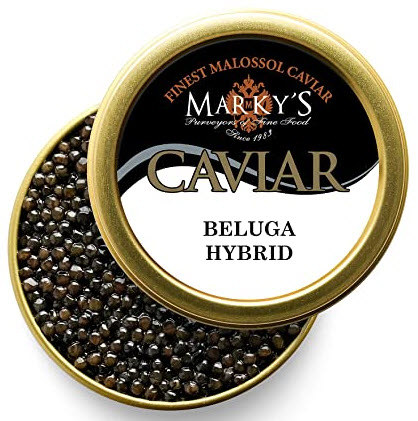Beluga Caviar
Arguably, the most famous type of caviar is the exclusive Beluga caviar. With its unusually large eggs, Beluga caviar has become the most well-known symbol of high-priced luxury roe. It comes from the Beluga sturgeon (Huso huso), which lives in the Caspian Sea and Black Sea basins, with occasional specimens also being found in the Adriatic Sea.
What colour is Beluga caviar?
Beluga caviar normally range in colour from light gray to a shade of grey that is so dark the caviar looks black.
The older the Beluga sturgeon, the lighter the grey of her eggs. In the trade, caviar made from pale grey eggs (i.e. eggs from older fish) tend to be more expensive than the darker ones.
Pearly white beluga caviar
 Very old Beluga sturgeons can produce eggs that are so pale they look pearly white rather than grey, but these females are rare – especially nowadays. In a world where the Beluga sturgeon populations are dwindling, it is unusually for a sturgeon to survive for a100 years or more. In the trade, females who produce pearly white eggs are called almas, which is the Persian word for diamond. Alma caviar is extremely expensive.
Very old Beluga sturgeons can produce eggs that are so pale they look pearly white rather than grey, but these females are rare – especially nowadays. In a world where the Beluga sturgeon populations are dwindling, it is unusually for a sturgeon to survive for a100 years or more. In the trade, females who produce pearly white eggs are called almas, which is the Persian word for diamond. Alma caviar is extremely expensive.
According to the Guiness Book of World Records 2017, Iranian beluga caviar of the alma-type is the most expensive caviar and costs from £20,000 per kilogram.
Eating Beluga caviar
As mentioned above, the eggs of the Beluga sturgeon are exceptionally large. A traditional and purist method of eating Beluga caviar is to place some caviar on the skin of your hand, between your index finger and your thumb, and then take the eggs into your mouth from there. When you have some eggs in your mouth, roll them around slowly and pop them inside your mouth to release the flavour.
The spoon
Metal utensils can make Beluga caviar take on a metallic taste. Therefore, Beluga caviar is normally not served in metal containers or on metal plates, and the spoon used is made from wood or bone. Some caviar spoons have a coating of mother-of-pearl over the part of the spoon that will be in contact with the caviar.
Accompaniments
Beluga caviar is often served alone, or with a mild toast.
About the Beluga sturgeon
The wild Beluga sturgeons are under serious threath and there is a great risk that they will soon become extinct. The species is listed as Critically Endangered on the IUCN 3.1. Red List.
- In 2005, the United States banned the import of Beluga cavair originating from the Caspian Sea and Black Sea basins.
- In 2006, the Convention on International Trade in Endangered Species (CITES) suspended the caviar trade with Azerbaijan, Bulgaria, China, Iran, Kazakhstan, Romania, Russia, Serbia and Montenegro, Turkmenistan, and Ukraine. Trade with Iran was not suspended, since Iran was deemed to be practicing effective conservation and policing of fisheries. (In this context, it can be good to remember that since 1979, a number of shorter and longer overall trading bans and embargoes against Iran have been imposed by countries and international entities.)
- In 2007, CITES began publishing yearly quotas for the trade in wild caviar from the Caspian Sea basin.
Farmed Beluga sturgeons
It is now possible to source Beluga caviar from Beluga sturgeons that are spawned and raised on fish farms. Hopefully, fish farming will reduce the pressure on the wild turgeon populations.
Beluga sturgeons
The Beluga sturgeon (Huso huso) can grow both old and big, but very old and very big specimens are unusual these days since the populations have dwindled, chiefly because of overfishing. Beluga sturgeons grow throughout their lives, and it normally takes decades for a Beluga sturgeon to become really big. The oldest known Beluga sturgeon was 118 years old.
The record for largest Beluga sturgeon is from 1827, when the populations were much bigger than today and more sturgeons survived to old age. The record-holding specimen was a female caught in the Volga estuary. She was 7.2 metres long and weighed 1571 kg. Female Beluga sturgeons are usually around 20% bigger than males of the same age.
Beluga sturgeons are predators. As juveniles, they feed on small invertebrates until they become big enough to switch to fish. As adult, they chiefly live on large fish, but also on crustaceans and molluscs. Really big Beluga sturgeons are known to have successfully killed and eaten young seals and waterfowl.
The name Beluga is derived from белый, the Russian word for the colour white.
